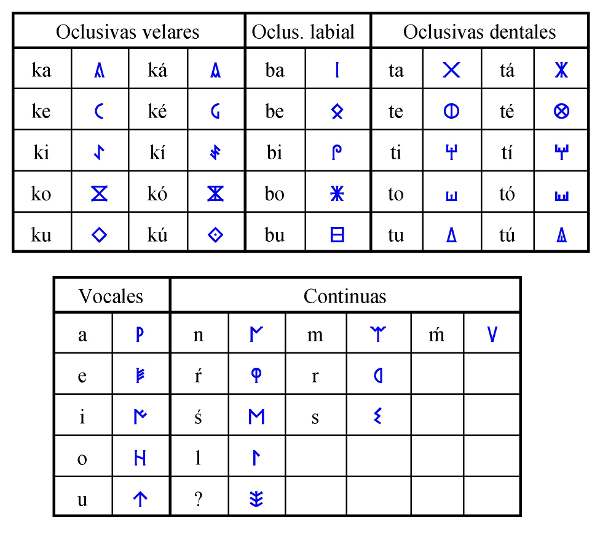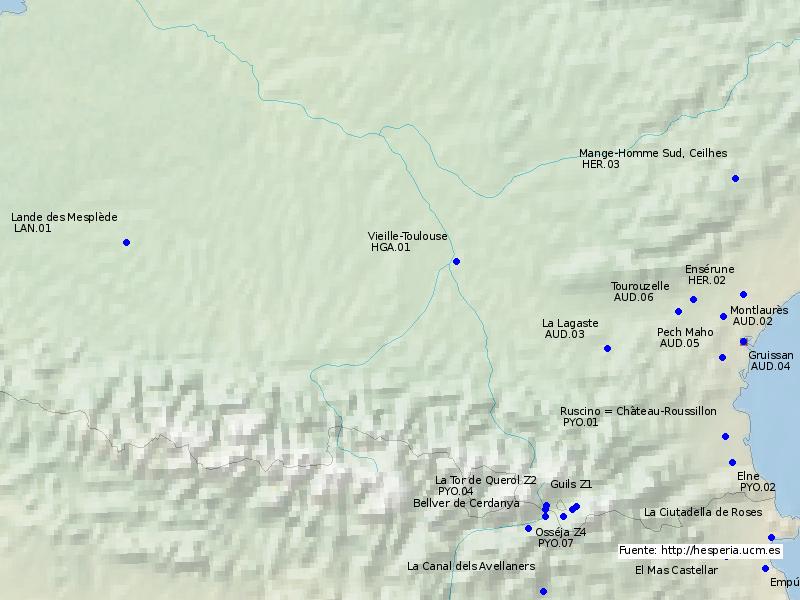Narbonensis
Access to the Narbonensis database
This section contains Palaeohispanic inscriptions originating from the south of France, most of which are located in oppida and places of trade in the Narbonensis region. Those that were known in 1980 were published in vol. 2 of MLH, where they make up epigraphic region B. The inscriptions are geographically distributed according to the following zones:
a) The coastal zone of the Narbonensis, from the French-Spanish border to the Hérault River. Special mention should be made of the site of Ensérune, which has provided one of the richest epigraphic collections both in terms of the inhabited city and particularly its necropolis, and also the site of Pech Maho, with its texts of a commercial nature, such as lead tablets. The sites of Elne (ancient Illiberris) and Château-Roussillon (Ruscino) should also be noted, as well as other more isolated finds at other points on the coast.
b) Rock inscriptions in Cerdanya, both in France and in Spain.
c) The tituli picti or painted inscriptions of Vieille-Toulouse, which constitute a homogenous collection of inscriptions of a markedly commercial nature.
d) Scattered discoveries, some of which are far removed from this context, such as the phialae of Vielle-Aubagnan. (Map of finds)
Like the adjacent northern coast of Catalonia, from the 6th century BCE the region witnessed commercial contacts with colonising peoples, especially the Greeks and Etruscans, who left epigraphic evidence in their own languages. The oldest Iberian texts, which come from the Ensérune necropolis, were written on imported Attic vases dating from the late 5th or early 4th century BCE. Iberian texts in this zone, especially those of Ensérune, also demonstrate the presence of Gauls, which is noticeable in their personal names. The painted inscriptions of Vielle-Toulouse bear witness to the inclusion of the region in the Italo-Roman economic sphere, prior to the abandoning of the use of Iberian in favour of Latin.
The corpus follows the arrangement established by Untermann in his MLH II, even when some of the inscriptions understood as Iberian by Untermann have been interpreted differently by later researchers (e.g. the Gallo-Etruscan of Ensérune). In this way, an exact correlation can be maintained, as far as possible, between the MLH Reference and the Hesperia Reference.
The Hesperia reference contains in its initials the abbreviation of the French département in which the findspot is located. The list of abbreviations is as follows:
AUD Aude
PYO Pyrénées Orientales
HGA Haute Garonne
HER Hérault
LAN Landes
Thus, the fragment of an Attic vase from Ensérune with the reference B.01.003 in MLH will be HER.02.003 in Hesperia. We have offered an MLH Reference, followed by SUP, for those inscriptions which Untermann included in his unpublished Supplement; the first lead tablet from Pech Maho has the MLH Reference B.07.34.SUP, which corresponds to the Hesperia Reference AUD.05.34. Inscriptions discovered after the preparation of the Supplement have no MLH Reference, although the fact they belong to epigraphic region B has been indicated.
The Hesperia list of references for Narbonensis can be accessed by clicking the link.
In 1968, Maluquer de Motes observed that some syllabic signs presented an additional stroke to the standard sign, whose function could have been to express the difference in voicing of the plosive involved, and later research has arrived at the conclusion that in certain zones and periods, especially in Catalonia and Narbonensis, a script was used which made a systematic distinction between voiced and unvoiced plosives. In the clearest cases it has been demonstrated that the sign with an additional stroke represents the unvoiced plosive, whilst the simple version represents the voiced one. Although this opposition is in many cases consistent, in others we find inadequacies, meaning that all the details of the use of the signs are still not fully known. It is suspected that this dual system was not in use throughout the whole Iberian period, having been replaced by a simple (and defective) system in later times.
In modern publications of Iberian texts, it is no longer possible to ignore this distinction, which is clearly significant. This is, then, one clear difference between the Hesperia Database and the MLH publication. Yet at the same time, since it is currently impossible to ensure that in every case an X, for example, might represent a voiced consonant /da/, we have favoured a descriptive rather than an interpretative transcription. In other words, we have transcribed any sign that has an additional stroke with an accentuated syllable (tá), leaving the traditional transcription (ta) for simple signs. Subsequent research will clarify how the different signs were used, their geographical and temporal extension and the main landmarks in their evolution. A publication like this, which differentiates between the two variants, will help to solve the matter.
PALAEOGRAPHIC VARIANTS
Given that we do not possess a unitary body of every palaeographic variant of Levantine or North-eastern Iberian –which is currently being drawn up—the palaeographic comments on the page on inscriptions belonging to the Narbonensian region refer to the variants established by Untermann in his volume II of the MLH, pp. 49-58. These are transcribed below for the reader’s convenience.
(Image map: the mouseover function opens variants)

Maps
Map 1: Archeological sites in the eastern part of the Narbonensis with their Hesperia references. Image map: click on Pech Maho, Ruscino, Ensérune and Lattes to see photos of the site.

Map 2: General view of the archeological sites of the Narbonensis with their Hesperia reference.
